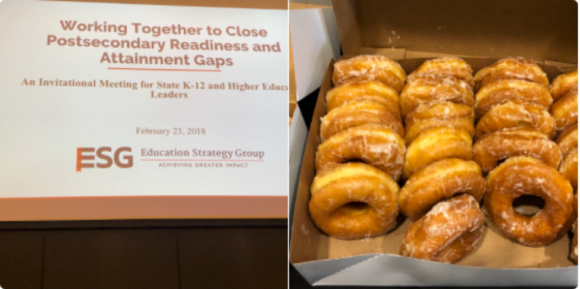Working Together to Close Attainment Gaps

There are two things K-12 and higher education leaders agree are necessary to close postsecondary preparation and attainment gaps: collaboration and donuts. Both were in full force last month at a meeting we hosted in Nashville, TN with leaders from seven states. The major takeaway: state leaders are prepared to work across the sectors to close gaps, but they admitted that they sometimes have to work against the grain to do it.
The economic data are abundantly clear: success in the future workforce requires some postsecondary training or education beyond high school. Between 2013 and 2023, the U.S. economy will create 55 million new jobs, and 40 million of them will require a postsecondary certificate or degree. And yet, currently, our education system is not preparing an adequate number of youth and adults to meet the projected workforce demands. While 84% of high students report they want to go to college, only 40% score at the college-ready level on high school assessments. This leads to a significant number of students ending up in remedial education, significantly reducing their likelihood of attaining a credential and, often, increasing their debt burden.
The state K-12 chiefs and higher education chancellors from Colorado, Indiana, Kentucky, New York, Rhode Island, Tennessee and Washington who came together last month clearly recognize the economic shift and performance gaps that exist, and they acknowledged that each of their sectors is now focused on addressing them. Supported by Lumina Foundation, 41 states now have postsecondary attainment goals designed to dramatically increase the percentage of people with meaningful credentials. And through the Every Student Succeeds Act, most states now have made college and career readiness a more substantial part of their K-12 performance goals.
Yet most of the leaders agreed that, left to their own devices, schools and colleges will operate in isolation of each other. K-12 schools will focus on their own goals and colleges will focus on theirs. Given how mutually dependent these systems are today—high schools are being measured in part by how many students are ready to succeed in college, and colleges are being measured by their success rates with those who enroll on their campuses—the leaders who convened at our meeting all agreed they need to collaborate if either sector is to achieve its goals.
Our hosts in Tennessee represent a compelling example of what can be achieved when systems set common goals, align priorities, and support each other in delivering a seamless experience for students. Working together to meet the Drive to 55 postsecondary attainment goal, the Tennessee Department of Education, Tennessee Higher Education Commission, and their advocacy partner, TN SCORE, have developed a collaborative set of strategies to increase the preparation, transition, and attainment success of students across the state. From delivering remedial coursework in high school (TN SAILS) to making college free for youth (TN Promise) and adults (TN Reconnect) to co-requisite remedial supports, the state’s policy toolbox is paying dividends. Tennessee is now recognized as the state with the greatest growth in K-12 student performance, leads the nation in FAFSA completion rates, and perhaps most importantly, has seen its college going rate increase by more than 5 percentage points in the last two years. All of that work has put the state ahead of pace to meet its Drive to 55 goal.
The Tennessee experience is inspiring, and leaders there have already set their sights on the next phase of that work. Their peer states emerged from the meeting with similarly ambitious steps they are prepared to take. For example, among other commitments:
- Three states will develop strategies for scaling advanced coursework opportunities with a specific focus on closing equity gaps in participation;
- Three states will develop a 12th grade transition course that, if successfully completed, will enable students to place directly into credit-bearing coursework upon postsecondary matriculation; and,
- Three states will publicize data on educator preparation programs, and provide support to higher education institutions in the use of that data.
ESG stands ready to assist these, and other, state leaders in their collaborative efforts to deliver pathways and supports so that students—especially those from traditionally underserved populations—can access and succeed in postsecondary education. We will go beyond detailing what needs to change, to showing how the change can occur, showcasing who has seen success as a result of the change, and supporting tangible actions that can achieve greater impact.
And we’ll even pick up the donuts.



